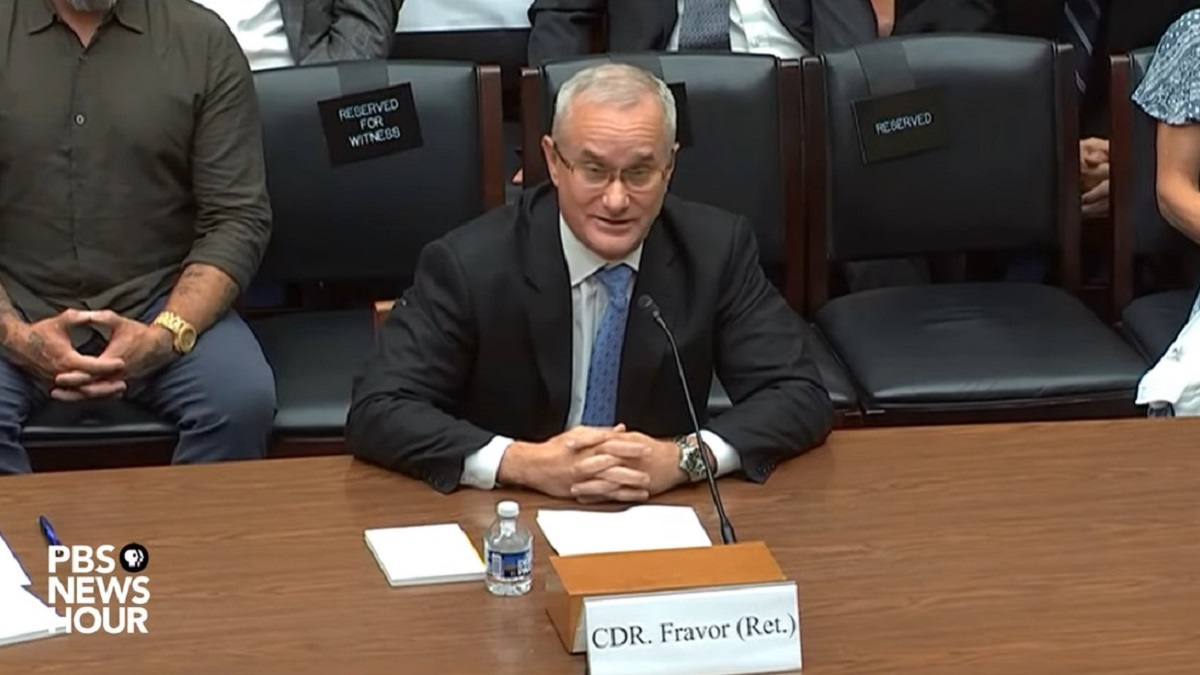
Navy CDR. David Fravor said the no U.S. military aircraft can shoot down the Tic Tac UFO he encountered in November 2004. Pic credit: PBS NewsHour/YouTube
During the congressional hearing on UFOs on Wednesday (July 26), Representative Nick Langworthy addressed the issue of the potential threat that UAPs constituted to national security.
All witnesses agreed that the U.S. military couldn’t shoot down or defend against a UAP with the capabilities exhibited by the “Tic Tac” UFO that Navy Cmdr. Fravor (ret.) and his squadron members encountered on November 14, 2004.
They agreed that the performance of the Tic Tac UFO was beyond any aircraft that the military possessed. Fravor said it defied all current human material science and did not believe any country had the technology to produce anything like it.
Langworthy concluded that the testimonies of the witnesses indicated that UAPs constituted a threat to U.S. national air space security.
The November 2004 Tic Tac UFO encounter
Fravor shared his views on the superior performance capabilities of the UAP while responding to an inquiry by Congressman Langworthy about the details of the famous incident.
The former Navy pilot explained that the incident occurred in November 2004 while he and some members of his Black Aces squadron (Strike Fighter Squadron 41/VFA-41) attached to the Nimitz Carrier Strike Group were on a training mission off the coast of San Diego.
Radar on the USS Princeton and Nimitz had been tracking multiple UAPs for two weeks, but there were no airborne fighters to investigate.
Fravor and his team happened to be airborne at the time the radars on USS Princeton detected them, and they received instructions to investigate.
The Navy pilot recalled that the weather was “perfect” for flying, with light winds and clear skies.
40-foot UFO had no visible signs of propulsion or wings
Fravor said they encountered a 40-foot object shaped like a Tic-Tac. He also compared it to the shape of a giant flying propane tank without visible wings.
The object did not appear on their aircraft radar, but the Princeton and the Nimitz tracked it. The UFO had no visible source of propulsion.
He said it was the first time he saw a craft that could fly without any sign of a “thermal exhaust.” It maneuvered abruptly and was aware they were there. It knew what it was doing.
The UAP could achieve extreme acceleration rates and go from stationary to supersonic speed instantaneously.
Fravor was not aware of any human-made aircraft that could perform the type of maneuvers or match the acceleration and speed performance of the Tic Tac UFO.
No U.S. military aircraft could have shot down the Tic Tac UFO
Fravor explained that his F/18-18 Hornet was not armed, but he did not feel threatened during the encounter.
When asked whether an armed fighter would have been able to shoot it down, Fravor said he did not believe the U.S. military had an aircraft that could shoot down the Tic Tac UFO.
No aircraft in the possession of the Air Force matched the Tic Tac UFO in speed and maneuverability. The UAP could have flown away in a “split second,” and no human-made aircraft would have been able to shoot it down.
Congressman Langworthy concluded that Fravor’s comments indicated that the U.S. military had a problem that needed further investigation.
He said that Fravor’s testimony provided evidence of a potential military threat to national air space security.
Tic Tac UFO defies current status of human material science
Langworthy then asked whether Fravor believed any other nation on Earth had the technology to produce such an advanced craft.
Fravor said he did believe any nation had the technology to produce an aircraft with the performance capabilities of the Tic Tac UFO.
He added that the performance of the UAP defied current material science.
Fravor believed the sighting was the most credible UAP/UFO sighting in history based on the sensors used to track it.
